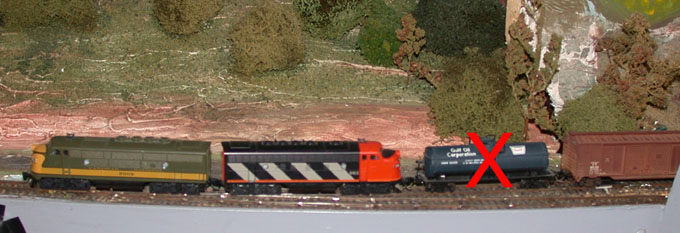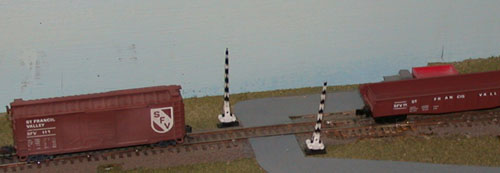|
Blocking a Crossing 
I have only been working on the St. Francis Valley
Railway for a couple of years and am bottom on the seniority list.
However, I occasionally manage to run train 393, a through freight from Sherbrooke
to Sorel. There is work to be done at the intermediate points of Richmond
and Drummondville.
Ottawa Valley Associated Railroaders
- OVAR, The Interchange, May 2005.Our train is properly blocked at Sherbrooke with the Richmond cars on the front, Drummondville in the middle and Sorel on the van. However, there’s a CGTX car buried in the middle which could cause some grief later. The manifest shows it to be an empty gasoline tank car. However, Sherbrooke is anxious to get rid of us because the yard is congested so we get the dispatcher’s permission and take off. Open the throttle to notch two and watch for the van to start moving. “Got ‘em all, 393.” With the train complete and properly stretched out I can increase to restricted speed: A speed that will permit stopping within one-half the range of vision of equipment, also prepared to stop short of a switch not properly lined and in no case exceeding fifteen miles per hour. “393 is on the main. Van is clear of the main line switch.” I can now open out the two units and accelerate to track speed for the run through Windsor. We are soon at Richmond where the yardmaster takes charge of the switching using the head end power. The Richmond block is quickly switched out and the engine goes back on the train and adds the Sorel cars inside the van. With the train properly blocked, the yardmaster tells me I am ready to go. “But sir,” (I must always be polite to those with much more seniority than I), “there is a CGTX tank car right next to the engine. I shouldn’t go like that.” “Ask me if I care! Its only going to Drummondville anyway.” “But sir, the regulations state quite clearly that a car with dangerous commodities or a flat car with a load that could shift, must not be placed next to the locomotive or van because of the potential danger to the crew.” “It is empty anyway, so it doesn’t matter.” “But sir, empty cars, because they contain residual gases, are more dangerous than full ones. Tank cars can only be marshaled next to the engine if they have been purged with an inert gas.” 
The Drummondville yardmaster chips in: “If you guys don’t stop messing about you are going to delay No. 8 (the hot passenger train). 393 is a long train tonight and we will need to saw by at Drummondville in any case. Aunt Tilley is travelling to Richmond tonight and there will be hell if No. 8 is delayed so that she misses her beauty sleep.” There is now much grumbling as the train is remarshalled to put a couple of box cars on the engine. The dispatcher gives me permission to run to Drummondville where I am to hold the main line. I quickly leave town. At Drummondville there is just time to do the work, including removing the errant CGTX tank car, before number 8 arrives. The dispatcher is anxious to get me away from Drummondville because the tail end is hanging out on the main line blocking the departure of the passenger train. No. 8 leaves on time and Aunt Tilley will get her beauty sleep tonight after all. By the time I get to Sorel the shift is almost over and I am looking forward to a cup of coffee and some of Hariet’s cookies, but there is one more trap to be avoided. With a long train tonight, my tail end is blocking a highway crossing. The Rule book says: No part of a train or engine may be allowed to stand on any part of a public crossing at grade, for a longer period than five minutes when vehicular or pedestrian traffic requires passage. It is approaching midnight but the yard switcher is not likely to get to my train until two or three in the morning so I had better cut the cars in the middle and stand the rear well clear of the crossing so that late night revelers do not crash into any part of the train. 
I can now go off shift and enjoy a cup of coffee with the rest of the operating crew. You may think that we are being overly precise or picky in the way we operate. However, this illustrates some of the problems faced by real railways and, by operating in a prototypical fashion, it makes the St. Francis Valley Railway a very interesting one to work on. Note. It very much depends upon the time the railway is modeled on. In steam days it was quite common to see tank cars placed next to the engine but the practice of placing barrier cars between the engine or van and cars containing dangerous commodities started before the Mississaugua derailment in November 1979. |
